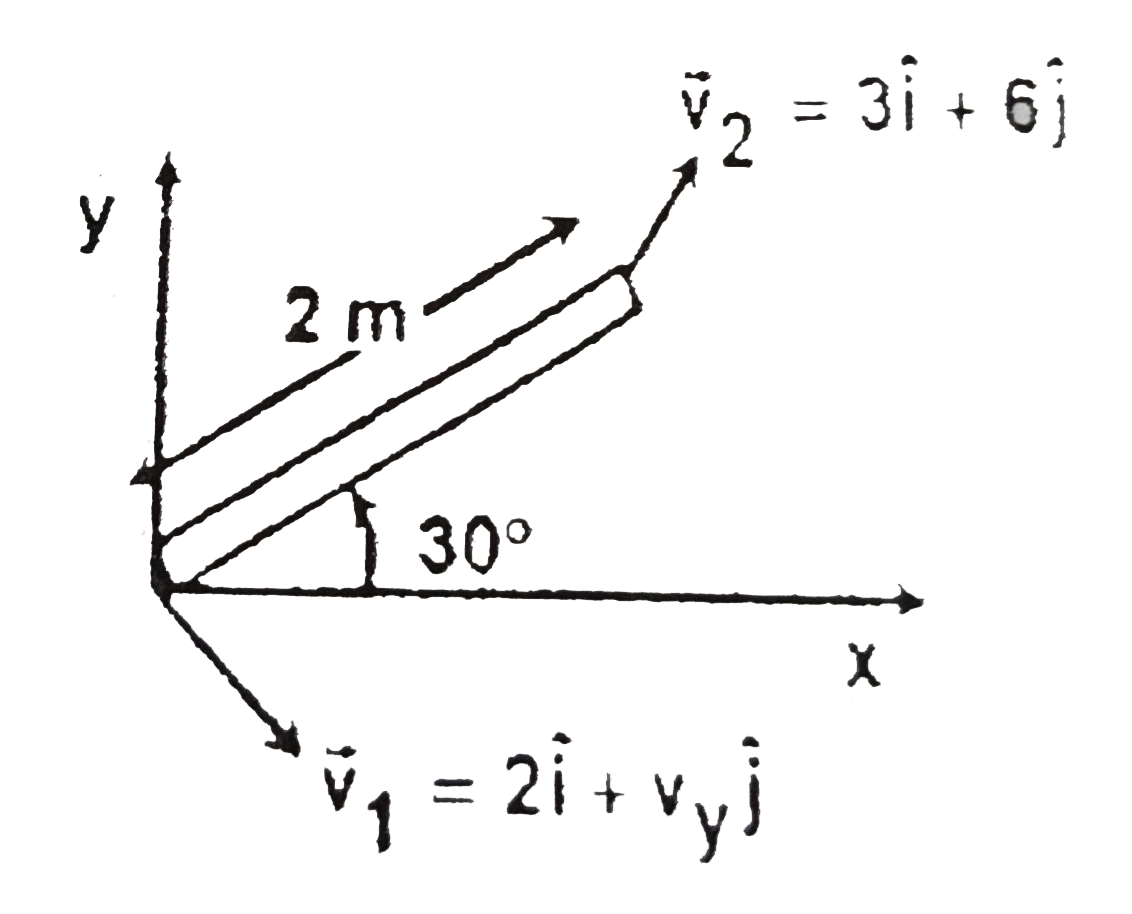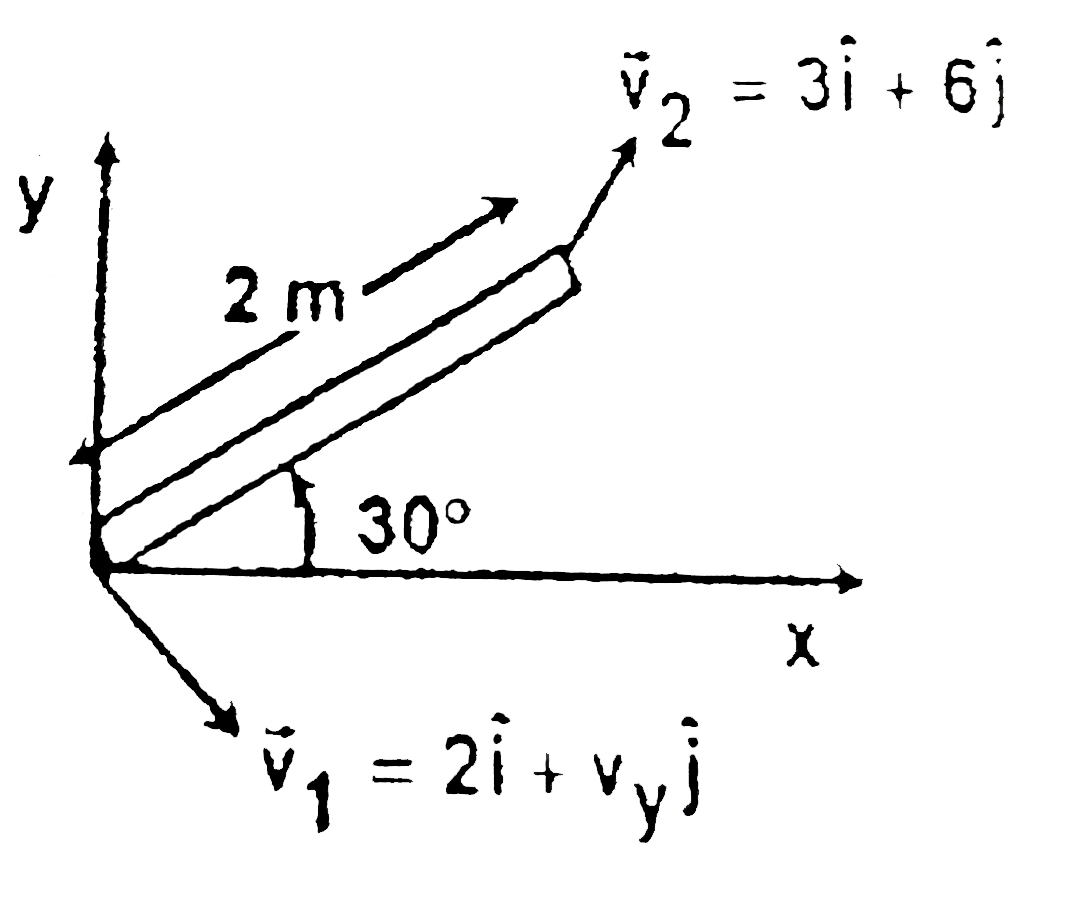A 120 g mass has a velocity →v=2ˆi+5ˆjms−1 at a certain instant. Its kinetic energy is
3 J
4 J
5 J
1.74 J
The correct Answer is:D
To find the kinetic energy of the mass, we can follow these steps:
Step 1: Convert the mass from grams to kilograms
The mass given is 120 g. To convert grams to kilograms, we use the conversion factor 1 kg=1000 g.
m=120 g1000=0.12 kg
Step 2: Determine the velocity vector
The velocity vector is given as:
→v=2^i+5^j m/s
Step 3: Calculate the magnitude of the velocity
The magnitude of the velocity vector can be calculated using the formula:
|→v|=√(vx)2+(vy)2
where vx=2 m/s and vy=5 m/s.
|→v|=√(2)2+(5)2=√4+25=√29 m/s
Step 4: Use the kinetic energy formula
The kinetic energy (KE) can be calculated using the formula:
KE=12mv2
Step 5: Substitute the values into the kinetic energy formula
Now, substitute the mass and the square of the magnitude of the velocity into the kinetic energy formula:
KE=12×0.12 kg×(√29)2
Since (√29)2=29:
KE=12×0.12 kg×29
Step 6: Calculate the kinetic energy
Now, calculate the value:
KE=0.06×29=1.74 J
Final Answer
The kinetic energy of the mass is:
KE=1.74 J
---
The mass given is 120 g. To convert grams to kilograms, we use the conversion factor 1 kg=1000 g.
The velocity vector is given as:
The magnitude of the velocity vector can be calculated using the formula:
The kinetic energy (KE) can be calculated using the formula:
Now, substitute the mass and the square of the magnitude of the velocity into the kinetic energy formula:
Now, calculate the value:
The kinetic energy of the mass is:
Topper's Solved these Questions
- BOOK - NCERT FINGERTPS ENGLISHCHAPTER - WORK , ENERGY AND POWEREXERCISE - NCERT18videos
WORK , ENERGY AND POWER
- BOOK - NCERT FINGERTPS ENGLISHCHAPTER - WORK , ENERGY AND POWEREXERCISE - ASSERTION & REASON15videos
WORK , ENERGY AND POWER
- BOOK - NCERT FINGERTPS ENGLISHCHAPTER - WAVESEXERCISE - Assertion And Reason15videos
WAVES
Similar Questions
A charged particle of specific charge (i.e.,Charge per unit mass 0 0.2 C/kg has velocity 2ˆi−3ˆjms−1 at some instant in a uniform magnetic field 5ˆi+2ˆj (tesla).Find the acceleration of the particle at this instant
View SolutionA 2.0 kg particle has a velocity of →v1=(2.0ˆi−3.0ˆj)m/s, and a 3.0kg particle has a velocity →v2=(1.0ˆi+6.0ˆj)m/s. How fast is the center of mass of the particle system moving?
View Solution
Knowledge Check
- Question 1 - Select One
A particle of mass 1 g moving with a velocity →v1=3ˆi−2ˆjms−1 experiences a perfectly in elastic collision with another particle of mass 2 g and velocity →v2=4ˆj−6ˆkms−1. The velocity of the particle is
A2.3ms−1B4.6ms−1C9.2ms−1D6ms−1
A body of mass 0.8 kg has intial velocity (3ˆi−4ˆj)ms−1 and final velocity (−6ˆj+2ˆk)ms−1. Find change in kinetic energy of the body?
View SolutionAn object has a velocity, v=(2ˆi+4ˆj)ms−1 at time t=0s. It undergoes a constant acceleration a=(ˆi−3ˆj)ms−2 for 4s. Then
(i) Find the coordinates of the object if it is at origin at t=0
(ii) Find the magnitude of its velocity at the end of 4s.View SolutionA rod AB of length 2m moves in horizontal x−y plane. At any instant end a of the rod is at origin and has velocity →vA=2ˆi+vyˆj. The other end B at the same instant is moving with velocity →vB=3ˆi+6ˆj. The rod makes an angle of 30∘ with the x−axis at this instant (see figure)
The magnitude of angular velocity of the rod is
 View Solution
View SolutionA rod AB of length 2m moves in horizontal x−y plane. At any instant end a of the rod is at origin and has velocity →vA=2ˆi+vyˆj. The other end B at the same instant is moving with velocity →vB=3ˆi+6ˆj. The rod makes an angle of 30∘ with the x−axis at this instant (see figure)
The value of vy is
 View Solution
View SolutionA body is projected with a velocity →v=(3ˆi+4ˆj)ms−1 The maximum height attained by the body is: (g=10ms−2)
View SolutionA particle of mass m has momentum p. Its kinetic energy will be
View SolutionIf a particle of charge 1μC is projected into a magnetic field →B=(2ˆi+yˆj−zˆk) T with a velocity →V=(4ˆi+2ˆj−6ˆk)ms−1, then it passes undeviated. If it is now projected with a velocity →V=ˆi+ˆj , then find the force experienced by it?
View Solution

